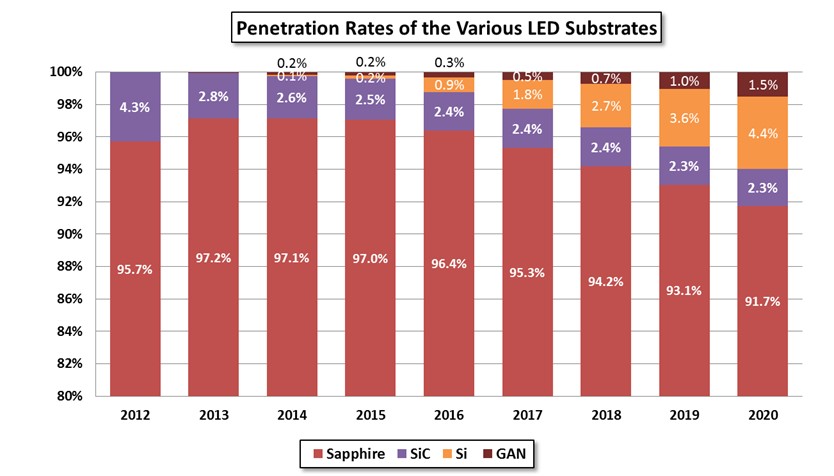The overall Front-End manufacturing trends for LED manufacturing are following the same path: decrease manufacturing costs, increase yield to improve binning, extract more light per mm² and per watt injected into the die… So all Front-End equipment makers are now developing or introducing new equipment (including MOCVD reactors) in order to be involved in the new investment wave that will happen from 2014 to 2017 as the new Yole Développement report "LED Front-End manufacturing trends" is highlighting.
What is extremely surprising is that LED manufacturing still uses methods and practices that would be considered outdated in most semiconductor industries (e.g.: manual wafer handling, with operators moving wafers with tweezers in (not so) clean rooms…). However, emergence of LED "giants" (such as Cree, Osram, Lumileds, Samsung or LG) have facilitated and speed up adoption of manufacturing paradigms from the IC industry to reduce overall manufacturing cost and increase products quality. The new mottos are moving from batch processing to single wafer, use automation, cluster tools, full cassette to cassette (…), deploy statistical process control, defect management (…), work on reduction of SKU and enterprise Management Systems (EMS)… All brand new topics not seen before in the LED industry.

As a matter of fact, gap will widen between Tier-1s and other players, pushing forward for industry consolidation. This is the major trend for the next 2 to 3 years, and it will happen!
Within major revolutions of the past 2 years, LED substrate is one of the key topic having impacted the LED Front-End industry, through increased demand for larger size Sapphire wafers with big players (such as LG, Sharp or Osram) moving to 6" wafers and Taiwanese players moving to 4" wafers.
In parallel to these evolution to larger wafer size, the demand for PSS wafers now has become mainstream in the industry (87% share as of Q1-2014) even if some questionings remain concerning key patent holders strategy and possible IP infringement.
In addition, the development of GaN-on-Si and GaN-on-GaN LEDs are now in mass production with companies such as Soraa for GaN or Toshiba for Si. However, market penetration of these alternative substrates will be tributary to future improvements in terms of performance and cost. Otherwise, GaN-on-Si and GaN-on-GaN LEDs will not be able to fully compete with Sapphire-based LEDs. But these innovative devices are now available on the market (and System Plus Consulting has made reverse engineering of them already: more here).
And the impact of the Sapphire industry evolution on the LED industry is likely to become bigger in the future with the recent partnership between GTAT and Apple (Q4-2013) to set up a large Sapphire manufacturing plant ($1 billion). The plant having a rough capacity of x2 the current qualified Sapphire capacity, it could totally modify the structure and the evolution of the Sapphire and the LED industries in the next years.
Flip chip is also contributing to the enhancement of the LED performances and cost adaptation. As flip chip technology gradually matures, LED manufacturers are actively developing this technology as it gives several advantages: larger light-emitting area and highest luminosity, better heat dissipation, adjustable dimensions and no wire-bonding.
Whereas such design was mostly in hand of some big LED manufacturers (such as Cree or Lumileds), in 2013, Taiwanese manufacturers have also started to develop it (Epistar, FOREPI and Genesis Photonics mostly).
In 2014, flip chip technology should also make its way into the middle power LED market. Lumileds started the hostility and announced in Q3-2013 its plans to introduce flip-chip technology into the middle power LED market as such type of device has drawn most attention from the market in 2013 with general lighting applications. Indeed, middle power LEDs (following the 2011 / 2012 overcapacity) have become mainstream in interior lighting applications.
The report presents a detailed analysis of LED Front-End manufacturing process (per process step) with additional highlights on LED chip design, key constituents of LED chip and main light extraction techniques.





